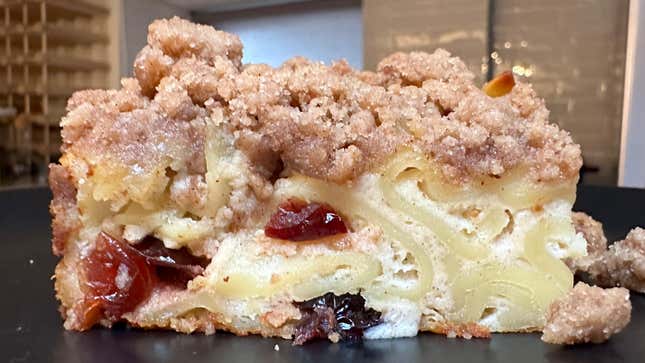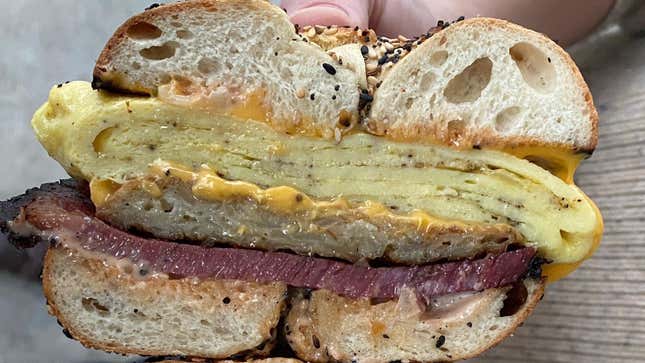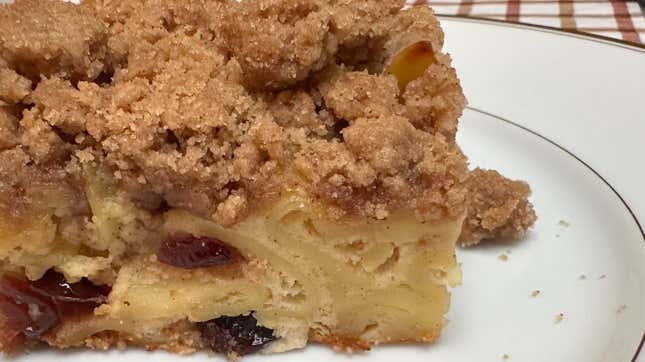
“There’s a lot of Christmas songs out there, and not too many Hanukkah songs,” Adam Sandler famously sang on a classic episode of Saturday Night Live. The same could just as easily have been said for Hanukkah foods. During the festival of lights, which begins at sundown this Thursday, Jewish people have traditionally eaten latkes (potato pancakes), sufganiyot (jelly doughnuts), and gelt (chocolate coins). But over the years, the classic Hanukkah menu has become a canvas for chefs to display their creativity, inventing fresh variations on the old standbys.
“From a culinary side, from a restaurant side, it’s important to have my team be creative,” Ben Goodnick, the executive chef at Summer House in Chicago, part of the Lettuce Entertain You Group, tells The Takeout.
Goodnick says customers like these variations on traditional foods, too. The restaurant has “so many regulars” who come in at least a few times per week, and those diners like to see Summer House mix things up.
In New Orleans, Saba Restaurant goes all out. During Hanukkah, it turns a private dining space into the L’Chaim Lounge, where diners can partake of drinks named for Jewish celebrities including Barbra Streisand, Jerry Seinfeld, and Ben Stiller. A non-alcoholic drink is named for owner Alon Shaya’s daughter Ruth.
“I love the festive energy, and I love the community that it brings,” Marie Guevara, Saba’s chef de cuisine, tells the Takeout. “The team really buys into the holiday.”
Letting loose with latkes
Both chefs are bringing innovations to latkes beyond the typical applesauce and sour cream. At Summer House, Goodnick offers three variations, including a roast leek latke plate, which includes two latkes topped with braised leeks and a red wine shallot reduction.
“It’s very comforting,” Goodnick says. “If you look outside Eastern European Jewish cuisine and broaden your scope, you see stews and braises all the time. It’s different enough, but familiar enough.”
At Saba, Guevara assembles a latke board (which has become a popular serving trend on Pinterest and elsewhere) with labneh, pickled shallots, roasted beets topped with tahini, and apple preserves.
And latkes are the star of Flour Moon Bagels’ riff on a latke and pastrami hash sandwich discovered at Baz Bagels in New York. Flour Moon, a New Orleans shop, offers a bagel sandwich with handmade latkes, locally smoked pastrami, egg, American cheese, and Russian dressing.

Sufganiyot are ready for their close-up
Unless you live in an area with a significant Jewish population, it’s possible you hadn’t encountered much sufganiyot until recently. This is the Jewish version of jelly doughnuts, akin to the Polish pączki eaten on Fat Tuesday.
The recipe dates as far back as 1485, when the first recipe for jelly doughnuts was found in a cookbook printed in Nuremberg, Germany, according to food historian Gil Marks. The original doughnut was a “jam sandwich,” with two circular pieces of dough pressed together and fried in lard.
The doughnuts are believed to have been spread to different countries by Polish Jews, who took them wherever they immigrated. In the 1920s, they were declared the official food of Hanukkah.
Now, they’ve become readily available in Jewish bakeries and delis across the United States. Sufganiyot was even a technical challenge this year on The Great Canadian Baking Show, where contestants were asked to make the two traditional kinds: one filled with strawberry jam, the other with custard.
Like pączki, sufganiyot’s flavor profile is getting wider. Depending on the source, fillings range from chocolate to pumpkin to tiramisu and dulce de leche. If you’ve over estimated your appetite for sufganiyot and find yourself with too many leftovers, writer Stephanie Ganz offers a recipe for a luscious bread pudding that combines stale raspberry jelly doughnuts with chocolate gelt.
New takes on classic Hanukkah dishes
Back in Chicago, Max Robbins of the Oakville Grill & Cellar, another Lettuce Entertain You restaurant, offers an updated (and rich) take on a Jewish classic. He has developed Duck Matzoh Ball Soup, whose ingredients include roasted duck meat, confit duck legs, chicken broth, cabbage, turmeric, coriander, and cumin.
The matzoh balls are made with duck fat (or chicken fat), seltzer water, four eggs, and matzoh meal. The soup comes together in half an hour, but for maximum flavor, it should cook for about five hours total. The matzoh balls go in last.
“It takes traditional matzoh ball soup and gives it an upgrade for the holidays with the use of rich, full-flavored duck confit meat,” Robbins tells The Takeout. If you don’t have time to prep your own duck legs, he recommends buying prepared ones.
Meanwhile, New York chef Zac Young, a familiar face on the Food Network, has amped up a traditional sweet side dish: noodle kugel. His Cranberry Crumb Cake Kugel moves away from the dense pudding that many people grew up with. “In this version, I add a crunch cake topping and tart cranberries to the mix,” he tells the Takeout. In addition to cranberries, “Feel free to use your favorite dried fruits,” he says, including raisins.

Recipe: Zac Young’s Cranberry Crumb Cake Kugel
Courtesy of Chef Zac Young
Ingredients for the kugel:
- 1 Tbsp. melted butter
- 1 (12-oz.) bag wide egg noodles
- 1/2 cup dried cranberries
- 4 large eggs
- 1/2 cup granulated sugar
- 1 cup cottage cheese
- 8 oz. cream cheese, at room temperature
- 1 cup whole milk
- 1 cup heavy cream
- 1/2 tsp. ground cinnamon
- 1/4 tsp. kosher salt
- 1 Tbsp. orange zest
Ingredients for the crumb topping:
- 1 1/4 cups all purpose flour
- 1 1/4 cups dark brown sugar
- 1 tsp. ground cinnamon
- 1/2 tsp. salt
- 10 Tbsp. unsalted butter, at room temperature
Preheat the oven to 325 degrees Fahrenheit. Grease a 9x13" baking dish or casserole dish with 1 tablespoon of melted butter.
Bring a large pot of salted water to a boil and cook the noodles for 6 to 7 minutes, until tender. Drain the noodles in a colander, and add the dried cranberries. Stir to combine, then place the mixture in the greased baking dish.
In a blender or food processor, add the eggs, sugar, cottage cheese, and cream cheese. Blend until smooth. Add the milk, cream, cinnamon, salt, and orange zest and blend well. Pour the liquid over the noodles. Cover with aluminum foil and bake for 30 minutes, until the custard has barely set.
In a medium bowl, combine the flour, brown sugar, cinnamon, and salt. Cut the butter into small pieces. Using your fingers or a pastry cutter, cut the butter into the dry mixture until pea-sized crumbs appear.
When the kugel is set, remove it from the oven. Take off the aluminum foil, and sprinkle the crumb mixture evenly on top. Return the dish to the oven and bake for another 30 to 35 minutes, until the crumble starts to brown slightly. Let the kugel cool for at least 30 minutes before slicing and serving.